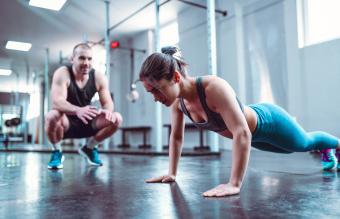
There are many exercises for restless leg syndrome (RLS), and you may want to give them a try if you're experiencing this frustrating condition. Additionally, many doctors suggest certain lifestyles changes in sleep and diet that may work together to provide you with relief.
About RLS
Restless leg syndrome is a condition in which an individual has a strong, almost overwhelming desire to move his or her legs, usually occurring in the evening during bedtime. For individuals suffering with RLS, relief only seems to come when the legs are moving. Occasionally, this condition will affect other parts of the body, as well.
Walking to Relieve RLS
It sounds simple enough, but many people don't get in enough walking per day. Now that so many people work at desk jobs, normal things like walking have become a lost art. Walking might be a simple exercise, but it can do wonders for the body. It gets your blood flowing, works your calf and thigh muscles, and improves your overall health. A daily walk can make a huge difference in your condition, as well as in your general sleeping habits.
A Temporary Solution
Walking can relieve some of the symptoms of RLS on an acute basis but may not stop the condition entirely. Note that overdoing it on walking may actually worsen symptoms of RLS, so if you're unaccustomed to physical activity start small and work your way up to longer walks as tolerated.
Walking Frequency
Walking (or other moderate exercise) should be done at least three times a week for best results in relieving RLS. It's best to exercise long before bedtime; otherwise, you may experience an increase in your symptoms when you try to fall asleep.
Yoga for RLS Relief
Yoga benefits for RLS are two-fold.
- The stretching aspects of yoga can help relieve some of the symptoms of RLS.
- Since RLS can be a very stressful condition to endure, the stress relief benefits of yoga cannot be overstated for someone with RLS.
Beneficial Poses
Try these relaxing yoga poses a few hours before bedtime.
- Downward Dog helps stretch your calves and hamstrings and can strengthen your body overall.
- Child's Pose is a beginner's pose and is restorative.
- Standing Forward Bend targets the hamstrings and calves while also increasing flexibility.
- Bridge Pose can be done with a towel or pillow propped under your hips if it's too difficult to do unassisted.
General Stretching
Much like yoga, stretching works to ease tight muscles and helps increase your flexibility. By stretching daily, you can relax not only your body, but your mind. Here are a few stretches to practice daily.
Toe Pull Calf Stretch
- Sit on the floor with your legs extended out in front of you.
- Reach forward with both hands and grasp your toes, pulling gently until you feel the stretch in your calves.
- Hold for 10 to 15 seconds and relax.
- Repeat several times.
Wall Stretch
- Stand a few inches from a wall.
- Prop one toe against the wall and lean forward, placing your hands against the wall for balance.
- Hold for 10 to 15 seconds and repeat with your other foot.
Seated Inner Thigh Stretch
- Sit on the floor and bring the soles of your feet together in front of you.
- Hold your feet and press your knees gently toward the floor.
- Don't worry if your knees don't touch the floor. You just want to feel the stretch in your inner thighs.
- Hold for 10 to 15 seconds and release.
Lying Hamstring Stretch
- Lie flat on your back with one leg extended above you and your toes pointed.
- Lace your fingers behind your knee and pull gently until you feel the stretch along the back of your thigh.
- Hold for 10 to 15 seconds and release.
- Repeat with your other foot.
Additional Tips
There are a few other things to try in addition to exercises for restless leg syndrome to help you get a better night's sleep.
- Create a regular, predictable sleep schedule.
- Eat a balanced, healthy diet of lean proteins, fruits, and vegetables.
- Get regular cardiovascular exercise.
- Heavy weight training may worsen the condition; instead, try lower impact strength work like yoga or light resistance bands.
- Eliminate alcohol and caffeine.
- Talk to your doctor about possible medications or therapies to relieve symptoms.
Holistic Treatment
Treatment of RLS may include medications, dietary changes, additional supplementation, and a regular exercise schedule. It's important to visit with a physician to ensure RLS isn't indicative of another medical issue. Find additional support through the Restless Leg Syndrome Foundation.







